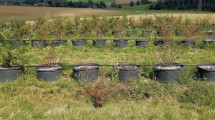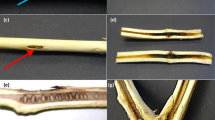Abstract
Sampling at blueberry farms found Botryosphaeriaceae fungi in five of seven farms sampled; overall incidence was 41.4%, with Neofusicoccum australe (79.0%), N. luteum (8.0%), N. ribis (8.0%) and N. parvum (5.0%). Sampling of nursery plants found infections in all four nurseries with 45% incidence in mainly asymptomatic plants, which were infected with N. australe (66.0%), N. parvum (31.5%) and N. ribis (2.5%). Asymptomatic propagation cuttings from one nursery were found to have external contamination of Botryosphaeriaceae DNA (90.0%) and internal infection (65.0%) by the four main species found in the blueberry farms and nurseries. For propagation media nested PCR showed that out of the 98 samples received, 43 samples were positive for the presence of Botryosphaeriaceae DNA (44.0%). Results from the SSCP indicated that N. australe, N. luteum, N. parvum/ N. ribis and Diplodia mutila were present in the propagation media received. Isolates of the four main species recovered from farms and nurseries were pathogenic on blueberry stems but pathogenicity differed significantly between species and isolates within a species, with N. ribis being the most pathogenic, then N. parvum, N. luteum and N. australe. Overall, the high rate of infection in nursery plants indicated that nurseries can be a major source of infection for blueberry farms. Since propagating cuttings are the likely sources of infection for nurseries, these should be targeted in the control strategies.

Similar content being viewed by others
References
Alves, A., Phillips, A. J. L., Henriques, I., & Correia, A. (2005). Evaluation of amplified ribosomal DNA restriction analysis (ARDRA) as a method for the identification of Botryosphaeria species. FEMS Microbiology Letters, 245, 221–229.
Amponsah, N. T., Jones, E. E., Ridgway, H. J., & Jaspers, M. V. (2009). First report of Neofusicoccum australe (Botryosphaeria australis), a cause of grapevine dieback in New Zealand. Australasian Plant Disease Notes, 4(1), 6–8.
Amponsah, N. T., Jones, E. E., Ridgway, H. J., & Jaspers, M. V. (2011). Identification, potential inoculum sources and pathogenicity of botryosphaeriaceous species associated with grapevine dieback disease in New Zealand. European Journal of Plant Pathology, 131(3), 467–482.
Baskarathevan, J., Jaspers, M. V., Jones, E. E., & Ridgway, H. J. (2012). Incidence and distribution of botryosphaeriaceous species causing dieback and decline in New Zealand vineyards. European Journal of Plant Pathology, 132(4), 549–560.
Billones-Baaijens, R., Jones, E. E., Ridgway, H. J., & Jaspers, M. V. (2013a). Virulence affected by assay parameters during grapevine pathogenicity studies with Botryosphaeriaceae nursery isolates. Plant Pathology, 62, 1214–1225.
Billones-Baaijens, R., Ridgway, H. J., Jones, E. E., Cruickshank, R. H., & Jaspers, M. V. (2013b). Prevalence and distribution of Botryosphaeriaceae species in New Zealand grapevine nurseries. European Journal of Plant Pathology, 135, 175–185.
Billones-Baaijens, R., Ridgway, H. J., Jones, E. E., & Jaspers, M. V. (2013c). Inoculum sources of Botryosphaeriaceae species in New Zealand grapevine nurseries. European Journal of Plant Pathology, 135, 159–174.
Blueberry Council, New Zealand. (2003). Blueberries 2002 statistical record. North American blueberry production. www.Blueberry.Org/publications/technical/tech%20brochure-sm.Pdf. 10.03.2013.
Creswell, T. C., & Milholland, R. D. (1988). Spore release and infection periods of Botryosphaeria dothidea on blueberry in North Carolina. Plant Disease, 72, 342–346.
Espinoza, J. G., Braceno, E. X., Chavez, E. R., Urbez-Torres, J. R., & Latorre, B. A. (2009). Neofusicoccum spp. associated with stem canker and dieback of blueberry in Chile. Plant Disease, 93(11), 1187–1194.
FreshFacts. (2007). http://www.hortresearch.co.nz/files/aboutus/factsandfigs/ff2007.pdf. Accessed 16 February 2013.
Milholland, R. D. (1971). Factors affecting sporulation and infection by the blueberry stem canker fungus, Botryosphaeria cortices. Phytopathology, 62, 137–139.
Milholland, R. D. (1995). Botryosphaeria stem blight. Pages 10–11 in. Compendium of Blueberry and Cranberry Diseases. Caruso F.L., and Ramsdell, D.C.(eds.), Compendium of blueberry and cranberry diseases, APS Press, St. Paul.
Pennycook, S. R., & Samuels, G. J. (1985). Botryosphaeria and Fusicoccum species associated with ripe fruit rot of Actinidia deliciosa (kiwifruit) in New Zealand. Mycotaxon, 24, 445–458.
Ridgway, H. J., Amponsah, N. T., Brown, D. S., Jones, E. E., & Jaspers, M. V. (2011). Detection of botryosphaeriaceous species in environmental samples using a multi-species primer pair. Plant Pathology, 60, 1118–1127.
Sammonds, J., Billones, R., Rocchetti, M., Ridgway, H. J., Walter, M., & Jaspers, M. V. (2009). Survey of blueberry farms for Botryosphaeria dieback and crown rot pathogens. New Zealand Plant Protection, 62, 238–242.
Smith, B. J. (2009). Botryosphaeria stem blight of southern blueberries: Cultivar susceptibility and effect of chemical treatments. Acta Horticulturae, 810, 385–394.
van Niekerk, J. M., Crous, P. W., Groenewald, J. Z., Fourie, P. H., & Halleen, F. (2004). DNA phylogeny, morphology and pathogenicity of Botryosphaeria species on grapevines. Mycologia, 96(4), 781–798.
van Niekerk, J. M., Calitz, F. J., Hallen, F., & Fourie, P. H. (2010). Temporal spore dispersal patterns of grapevine trunk pathogens in South Africa. European of Journal Plant Pathology, 127, 375–390.
Wright, A. F., & Harmon, P. F. (2010). Identification of species in the Botryosphaeriaceae Family causing stem blight on southern highbush blueberry in Florida. Plant Disease, 94, 966–997.
Xu, C., Zhang, H., Zhou, Z., Hu, T., Wang, S., Wang, Y., & Cao, K. (2015). Identification and distribution of Botryosphaeriaceae species associated with blueberry stem blight in China. European Journal of Plant Pathology, 143(4), 737–752.
Yu, L., Rarisara, I., Xu, S. G., Wu, X., & Zhao, J. R. (2012). First report of stem blight of blueberry caused by Botryosphaeria dothidea in China. Plant Disease, 96(11), 1697.
Acknowledgements
We thank Blueberries New Zealand and Lincoln University for funding this research and the blueberry growers who provided us with their valuable plant and propagation materials. Statistical advice was provided by Dr. Dean O’Connell.
Author information
Authors and Affiliations
Corresponding author
Ethics declarations
Funding was provided by Lincoln University (Postgraduate research scholarship awarded to the first author) and Blueberries New Zealand. None of the authors declare a conflict of interest, with all authors consenting to publication.
Rights and permissions
About this article
Cite this article
Tennakoon, K.M.S., Ridgway, H.J., Jaspers, M.V. et al. Botryosphaeriaceae species associated with blueberry dieback and sources of primary inoculum in propagation nurseries in New Zealand. Eur J Plant Pathol 150, 363–374 (2018). https://doi.org/10.1007/s10658-017-1283-9
Accepted:
Published:
Issue Date:
DOI: https://doi.org/10.1007/s10658-017-1283-9




